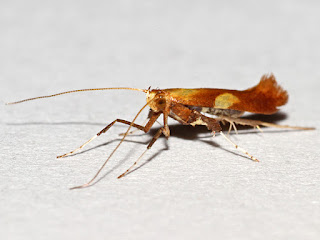Indeed at the moment it's not clear (to us) that it's been recorded anywhere in the UK very often. There may well be more records that we have not yet unearthed but so far we know of one in Kent in 2011, published as being the first for Britain, possibly an earlier record in Scotland, one in Leicestershire in 2013 one in coastal Suffolk in 2014 [edit: Matthew Deans has informed us there have now been 2 coastal Suffolk records]. The Kent individual was found at a time when there weren't many migrants around so it was suspected that there might be a population in the area, and the species is expanding its range in northern Europe, so is likely to colonise the UK. Well, whether there have been any more records or not, I think we can now safely say it has colonised the UK, for we didn't just find one, we found THREE! Here they are:
Pine Cone Tortrixes Gravitarmata margarotana (1 male gen det), Cranwich Heath, 20th May
(PS: is the plural of Tortrix 'Tortrixes' or 'Tortrices'?)
Other tortrix moths included two more personal highlights, both species I'd not seen before: the nationally scarce Pine Bud Moth Pseudococcyx turionella and Black-bordered Piercer Pammene argyrana.
Pine Bud Moth Pseudococcyx turionella, Cranwich Heath, 20th May
Black-bordered Piercer (male, gen det) Pammene argyrana, Cranwich Heath, 20th May
Another pine-feeding Tortrix that I don't see at home (though I have seen a few times elsewhere) was Pine Bell Epinotia rubiginosana, of which we saw at least 2.
Pine Bell Epinotia rubiginosana, Cranwich Heath, 20th May
A good selection of other micros too: 2 Bordered Carls Coptotriche marginea, Bird’s-nest Moth Tinea trinotella, New Oak Slender Caloptilia robustella, Beech Midget Phyllonorycter maestingella, 8 Plain Fanners Glyphipterix fuscoviridella, 5 Wood-rush Case-bearers Coleophora otidipennella, Red-brindled Dwarf Elachista rufocinerea, Triple-spot Dwarf Elachista maculicerusella, Swan-feather Dwarf Elachista argentella, 4 Dark-barred Tortrices Syndemis musculana, 8 Hook-streaked Grass-Veneers Crambus lathoniellus, 5 Meadow Greys Scoparia pyralella, Common Grey Scoparia ambigualis and 2 Straw-barred Pearls Pyrausta despicata.
New Oak Slender Caloptilia robustella (male, gen det), Cranwich Heath, 20th May
Wood-rush Case-bearer Coleophora otidipennella (female, gen det), Cranwich Heath, 20th May
Triple-spot Dwarf Elachista maculicerusella, Cranwich Heath, 20th May
Straw-barred Pearl Pyrausta despicata, Cranwich Heath, 20th May
Pick of the bunch of macros has to go to the nationally scarce and Breckland speciality 2 Oblique Stripeds (another awkward plural...).
Oblique Striped, Cranwich Heath, 20th May
One of the two had a much stronger red band on the underwing than the other.
Other macros were Pebble Hook-tip, Chinese Character, Red Twin-spot Carpet, 3 Common Carpets, Streamer, Purple Bar, 6 Grey Pine Carpets, Spruce Carpet, 18 Green Carpets, Mottled Pug, 2 Common Pugs, Brindled Pug, 3 Oak-tree Pugs, 2 Yellow-barred Brindles, 5 Tawny-barred Angles, 2 Latticed Heaths, 2 Scorched Wings, Brimstone Moth, Scalloped Hazel, Waved Umber, White-pinion Spotted, 2 Great Prominents, 5 Pale Tussocks, Orange Footman, Ruby Tiger, Least Black Arches, Flame Shoulder, 2 Shears, Knot Grass, Treble Lines, Marbled White Spot, Nut-tree Tussock and Spectacle.
Purple Bar, Cranwich Heath, 20th May
Knot Grass, Cranwich Heath, 20th May
Latticed Heath, Cranwich Heath, 20th May
Ruby Tiger, Cranwich Heath, 20th May
Marbled White Spot, Cranwich Heath, 20th May
Scorched Wing, Cranwich Heath, 20th May
Pale Tussock, Cranwich Heath, 20th May
Shears, Cranwich Heath, 20th May
Tawny-barred Angle, Cranwich Heath, 20th May
Mottled Pug, Cranwich Heath, 20th May
Pebble Hook-tip, Cranwich Heath, 20th May
Bugs included several Harpocera thoracica and a leafhopper that hopped away before I could get an ID on it.
Harpocera thoracica, Cranwich Heath, 20th May
unidentified leafhopper, Cranwich Heath, 20th May
Beetles included 4 Cockchafers and the weevil Phyllobius roboretanus, one I'd not identified previously.
Phyllobious roboretanus, Cranwich Heath, 20th May
I think this larger Phyllobius was Phyllobius maculicornis but I'm not 100% sure. Would be new for me again if so, but very hard to separate from another Phyllobius that I have seen.
probable Phyllobius maculicornis, Cranwich Heath, 20th May
Only one caddisfly, another Limnephilus auricula, but a few similar Mayflies, the one I retained for checking proving to be Brachycercus harrisellus, a new species for me distinguished from its congeners by having its rear legs spaced further apart.




























No comments:
Post a Comment